LFIEM: Lightweight Filter-Based Image Enhancement Model
Oktai Tatanov,
Aleksei Samarin

Auto-TLDR; Image Retouching Using Semi-supervised Learning for Mobile Devices
Similar papers
CURL: Neural Curve Layers for Global Image Enhancement
Sean Moran, Steven Mcdonagh, Greg Slabaugh
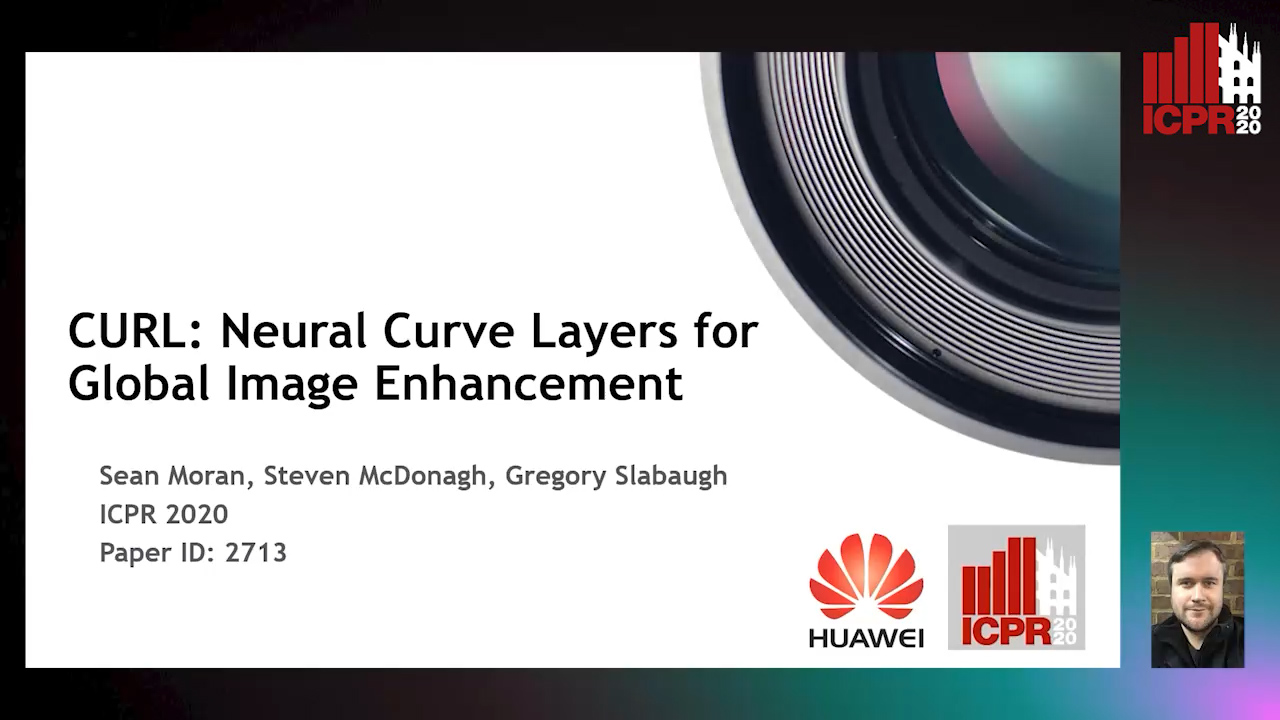
Auto-TLDR; CURL: Neural CURve Layers for Image Enhancement
Abstract Slides Poster Similar
Thermal Image Enhancement Using Generative Adversarial Network for Pedestrian Detection
Mohamed Amine Marnissi, Hajer Fradi, Anis Sahbani, Najoua Essoukri Ben Amara

Auto-TLDR; Improving Visual Quality of Infrared Images for Pedestrian Detection Using Generative Adversarial Network
Abstract Slides Poster Similar
Automatical Enhancement and Denoising of Extremely Low-Light Images
Yuda Song, Yunfang Zhu, Xin Du

Auto-TLDR; INSNet: Illumination and Noise Separation Network for Low-Light Image Restoring
Abstract Slides Poster Similar
Dynamic Low-Light Image Enhancement for Object Detection Via End-To-End Training
Haifeng Guo, Yirui Wu, Tong Lu

Auto-TLDR; Object Detection using Low-Light Image Enhancement for End-to-End Training
Abstract Slides Poster Similar
SIDGAN: Single Image Dehazing without Paired Supervision
Pan Wei, Xin Wang, Lei Wang, Ji Xiang, Zihan Wang

Auto-TLDR; DehazeGAN: An End-to-End Generative Adversarial Network for Image Dehazing
Abstract Slides Poster Similar
Towards Artifacts-Free Image Defogging
Gabriele Graffieti, Davide Maltoni

Auto-TLDR; CurL-Defog: Learning Based Defogging with CycleGAN and HArD
Adaptive Image Compression Using GAN Based Semantic-Perceptual Residual Compensation
Ruojing Wang, Zitang Sun, Sei-Ichiro Kamata, Weili Chen

Auto-TLDR; Adaptive Image Compression using GAN based Semantic-Perceptual Residual Compensation
Abstract Slides Poster Similar
Boosting High-Level Vision with Joint Compression Artifacts Reduction and Super-Resolution
Xiaoyu Xiang, Qian Lin, Jan Allebach

Auto-TLDR; A Context-Aware Joint CAR and SR Neural Network for High-Resolution Text Recognition and Face Detection
Abstract Slides Poster Similar
A NoGAN Approach for Image and Video Restoration and Compression Artifact Removal
Mameli Filippo, Marco Bertini, Leonardo Galteri, Alberto Del Bimbo

Auto-TLDR; Deep Neural Network for Image and Video Compression Artifact Removal and Restoration
Explorable Tone Mapping Operators
Su Chien-Chuan, Yu-Lun Liu, Hung Jin Lin, Ren Wang, Chia-Ping Chen, Yu-Lin Chang, Soo-Chang Pei
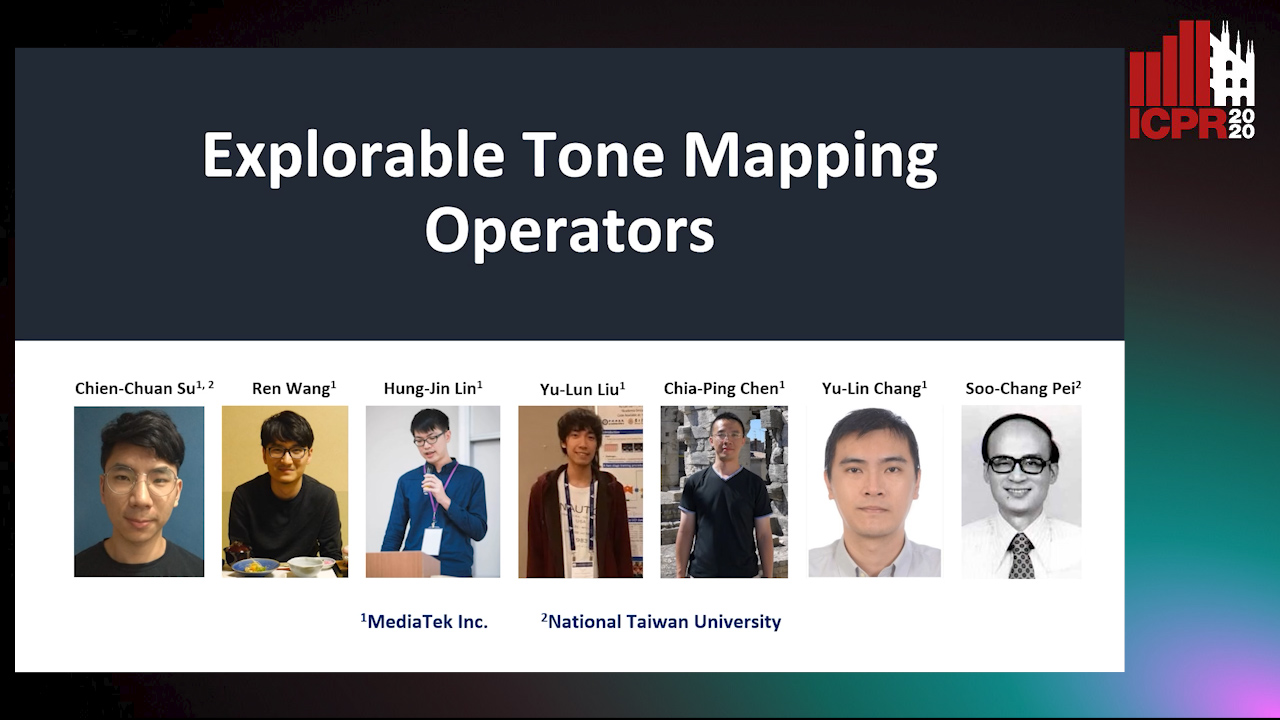
Auto-TLDR; Learning-based multimodal tone-mapping from HDR images
Abstract Slides Poster Similar
Local Facial Attribute Transfer through Inpainting
Ricard Durall, Franz-Josef Pfreundt, Janis Keuper

Auto-TLDR; Attribute Transfer Inpainting Generative Adversarial Network
Abstract Slides Poster Similar
Video Lightening with Dedicated CNN Architecture
Li-Wen Wang, Wan-Chi Siu, Zhi-Song Liu, Chu-Tak Li, P. K. Daniel Lun

Auto-TLDR; VLN: Video Lightening Network for Driving Assistant Systems in Dark Environment
Abstract Slides Poster Similar
Cycle-Consistent Adversarial Networks and Fast Adaptive Bi-Dimensional Empirical Mode Decomposition for Style Transfer
Elissavet Batziou, Petros Alvanitopoulos, Konstantinos Ioannidis, Ioannis Patras, Stefanos Vrochidis, Ioannis Kompatsiaris

Auto-TLDR; FABEMD: Fast and Adaptive Bidimensional Empirical Mode Decomposition for Style Transfer on Images
Abstract Slides Poster Similar
LiNet: A Lightweight Network for Image Super Resolution
Armin Mehri, Parichehr Behjati Ardakani, Angel D. Sappa

Auto-TLDR; LiNet: A Compact Dense Network for Lightweight Super Resolution
Abstract Slides Poster Similar
Hierarchically Aggregated Residual Transformation for Single Image Super Resolution

Auto-TLDR; HARTnet: Hierarchically Aggregated Residual Transformation for Multi-Scale Super-resolution
Abstract Slides Poster Similar
RSAN: Residual Subtraction and Attention Network for Single Image Super-Resolution
Shuo Wei, Xin Sun, Haoran Zhao, Junyu Dong

Auto-TLDR; RSAN: Residual subtraction and attention network for super-resolution
Phase Retrieval Using Conditional Generative Adversarial Networks
Tobias Uelwer, Alexander Oberstraß, Stefan Harmeling

Auto-TLDR; Conditional Generative Adversarial Networks for Phase Retrieval
Abstract Slides Poster Similar
VITON-GT: An Image-Based Virtual Try-On Model with Geometric Transformations
Matteo Fincato, Federico Landi, Marcella Cornia, Fabio Cesari, Rita Cucchiara
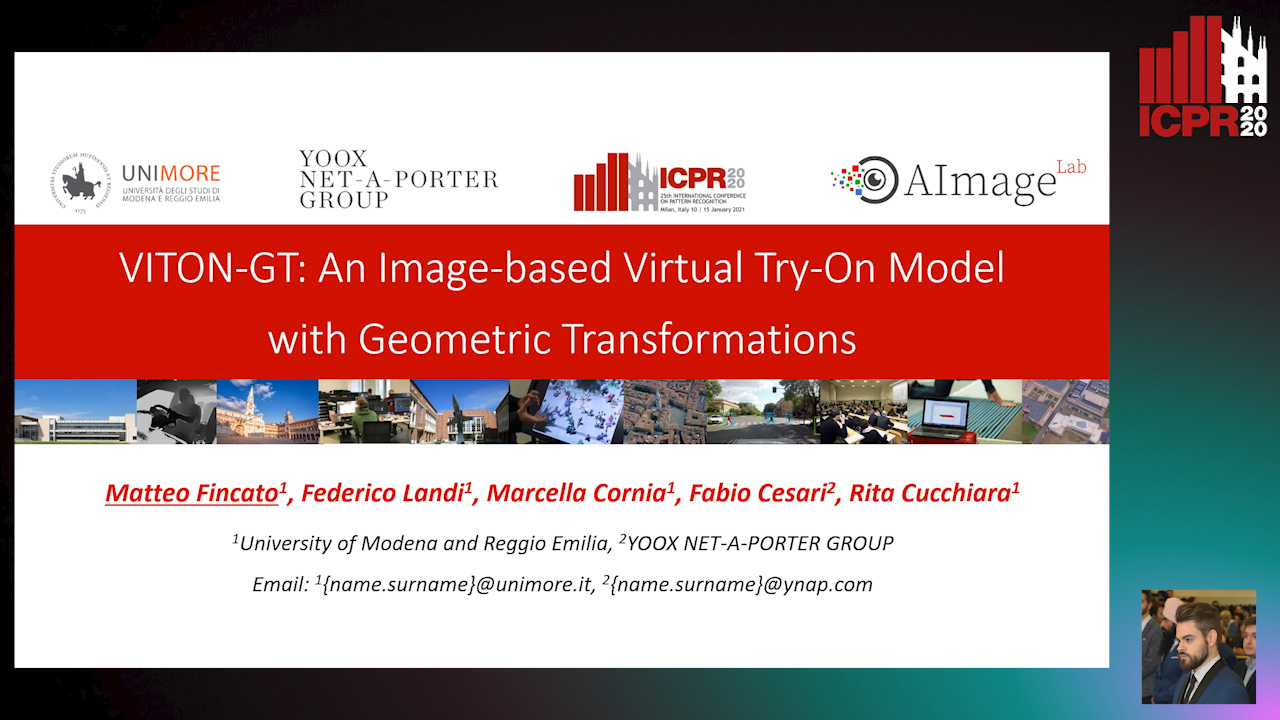
Auto-TLDR; VITON-GT: An Image-based Virtual Try-on Architecture for Fashion Catalogs
Abstract Slides Poster Similar
Free-Form Image Inpainting Via Contrastive Attention Network
Xin Ma, Xiaoqiang Zhou, Huaibo Huang, Zhenhua Chai, Xiaolin Wei, Ran He

Auto-TLDR; Self-supervised Siamese inference for image inpainting
Continuous Learning of Face Attribute Synthesis
Ning Xin, Shaohui Xu, Fangzhe Nan, Xiaoli Dong, Weijun Li, Yuanzhou Yao

Auto-TLDR; Continuous Learning for Face Attribute Synthesis
Abstract Slides Poster Similar
Super-Resolution Guided Pore Detection for Fingerprint Recognition
Syeda Nyma Ferdous, Ali Dabouei, Jeremy Dawson, Nasser M. Nasarabadi

Auto-TLDR; Super-Resolution Generative Adversarial Network for Fingerprint Recognition Using Pore Features
Abstract Slides Poster Similar
The Effect of Image Enhancement Algorithmson Convolutional Neural Networks
José A. Rodríguez-Rodríguez, Miguel A. Molina-Cabello, Rafaela Benítez-Rochel, Ezequiel López-Rubio
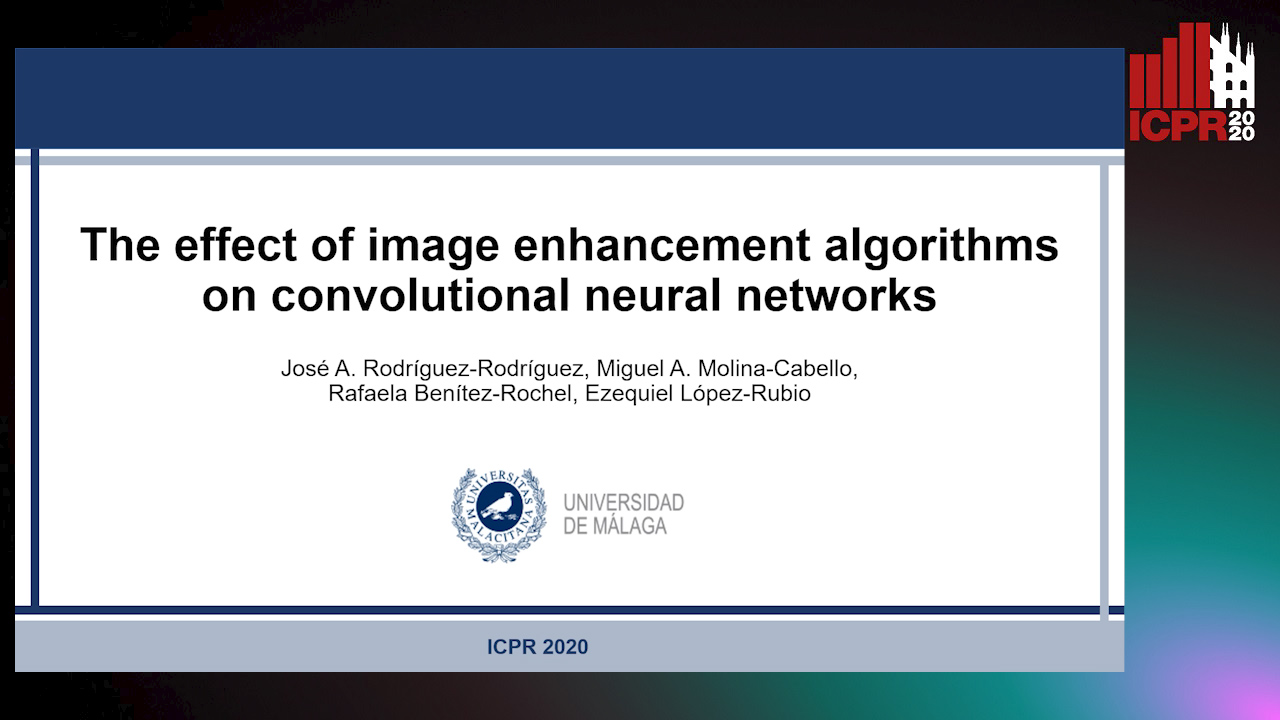
Auto-TLDR; Optimization of Convolutional Neural Networks for Image Classification
Abstract Slides Poster Similar
Galaxy Image Translation with Semi-Supervised Noise-Reconstructed Generative Adversarial Networks
Qiufan Lin, Dominique Fouchez, Jérôme Pasquet

Auto-TLDR; Semi-supervised Image Translation with Generative Adversarial Networks Using Paired and Unpaired Images
Abstract Slides Poster Similar
Deep Universal Blind Image Denoising

Auto-TLDR; Image Denoising with Deep Convolutional Neural Networks
Deep Fusion of RGB and NIR Paired Images Using Convolutional Neural Networks

Auto-TLDR; Deep Fusion of RGB and NIR paired images in low light condition using convolutional neural networks
Abstract Slides Poster Similar
DR2S: Deep Regression with Region Selection for Camera Quality Evaluation
Marcelin Tworski, Stéphane Lathuiliere, Salim Belkarfa, Attilio Fiandrotti, Marco Cagnazzo

Auto-TLDR; Texture Quality Estimation Using Deep Learning
Abstract Slides Poster Similar
On-Device Text Image Super Resolution
Dhruval Jain, Arun Prabhu, Gopi Ramena, Manoj Goyal, Debi Mohanty, Naresh Purre, Sukumar Moharana

Auto-TLDR; A Novel Deep Neural Network for Super-Resolution on Low Resolution Text Images
Abstract Slides Poster Similar
Semi-Supervised Deep Learning Techniques for Spectrum Reconstruction
Adriano Simonetto, Vincent Parret, Alexander Gatto, Piergiorgio Sartor, Pietro Zanuttigh

Auto-TLDR; hyperspectral data estimation from RGB data using semi-supervised learning
Abstract Slides Poster Similar
MBD-GAN: Model-Based Image Deblurring with a Generative Adversarial Network

Auto-TLDR; Model-Based Deblurring GAN for Inverse Imaging
Abstract Slides Poster Similar
UCCTGAN: Unsupervised Clothing Color Transformation Generative Adversarial Network
Shuming Sun, Xiaoqiang Li, Jide Li

Auto-TLDR; An Unsupervised Clothing Color Transformation Generative Adversarial Network
Abstract Slides Poster Similar
Detail-Revealing Deep Low-Dose CT Reconstruction
Xinchen Ye, Yuyao Xu, Rui Xu, Shoji Kido, Noriyuki Tomiyama

Auto-TLDR; A Dual-branch Aggregation Network for Low-Dose CT Reconstruction
Abstract Slides Poster Similar
Image Inpainting with Contrastive Relation Network
Xiaoqiang Zhou, Junjie Li, Zilei Wang, Ran He, Tieniu Tan

Auto-TLDR; Two-Stage Inpainting with Graph-based Relation Network
Edge-Guided CNN for Denoising Images from Portable Ultrasound Devices
Yingnan Ma, Fei Yang, Anup Basu

Auto-TLDR; Edge-Guided Convolutional Neural Network for Portable Ultrasound Images
Abstract Slides Poster Similar
Position-Aware and Symmetry Enhanced GAN for Radial Distortion Correction
Yongjie Shi, Xin Tong, Jingsi Wen, He Zhao, Xianghua Ying, Jinshi Hongbin Zha

Auto-TLDR; Generative Adversarial Network for Radial Distorted Image Correction
Abstract Slides Poster Similar
DSPNet: Deep Learning-Enabled Blind Reduction of Speckle Noise
Yuxu Lu, Meifang Yang, Liu Wen

Auto-TLDR; Deep Blind DeSPeckling Network for Imaging Applications
D3Net: Joint Demosaicking, Deblurring and Deringing
Tomas Kerepecky, Filip Sroubek

Auto-TLDR; Joint demosaicking deblurring and deringing network with light-weight architecture inspired by the alternating direction method of multipliers
Future Urban Scenes Generation through Vehicles Synthesis
Alessandro Simoni, Luca Bergamini, Andrea Palazzi, Simone Calderara, Rita Cucchiara

Auto-TLDR; Predicting the Future of an Urban Scene with a Novel View Synthesis Paradigm
Abstract Slides Poster Similar
Deep Iterative Residual Convolutional Network for Single Image Super-Resolution
Rao Muhammad Umer, Gian Luca Foresti, Christian Micheloni

Auto-TLDR; ISRResCNet: Deep Iterative Super-Resolution Residual Convolutional Network for Single Image Super-resolution
Fast Region-Adaptive Defogging and Enhancement for Outdoor Images Containing Sky
Zhan Li, Xiaopeng Zheng, Bir Bhanu, Shun Long, Qingfeng Zhang, Zhenghao Huang

Auto-TLDR; Image defogging and enhancement of hazy outdoor scenes using region-adaptive segmentation and region-ratio-based adaptive Gamma correction
Abstract Slides Poster Similar
A GAN-Based Blind Inpainting Method for Masonry Wall Images
Yahya Ibrahim, Balázs Nagy, Csaba Benedek

Auto-TLDR; An End-to-End Blind Inpainting Algorithm for Masonry Wall Images
Abstract Slides Poster Similar
Single Image Super-Resolution with Dynamic Residual Connection
Karam Park, Jae Woong Soh, Nam Ik Cho

Auto-TLDR; Dynamic Residual Attention Network for Lightweight Single Image Super-Residual Networks
Abstract Slides Poster Similar
Learning Image Inpainting from Incomplete Images using Self-Supervision
Sriram Yenamandra, Rohit Kumar Jena, Ansh Khurana, Suyash Awate
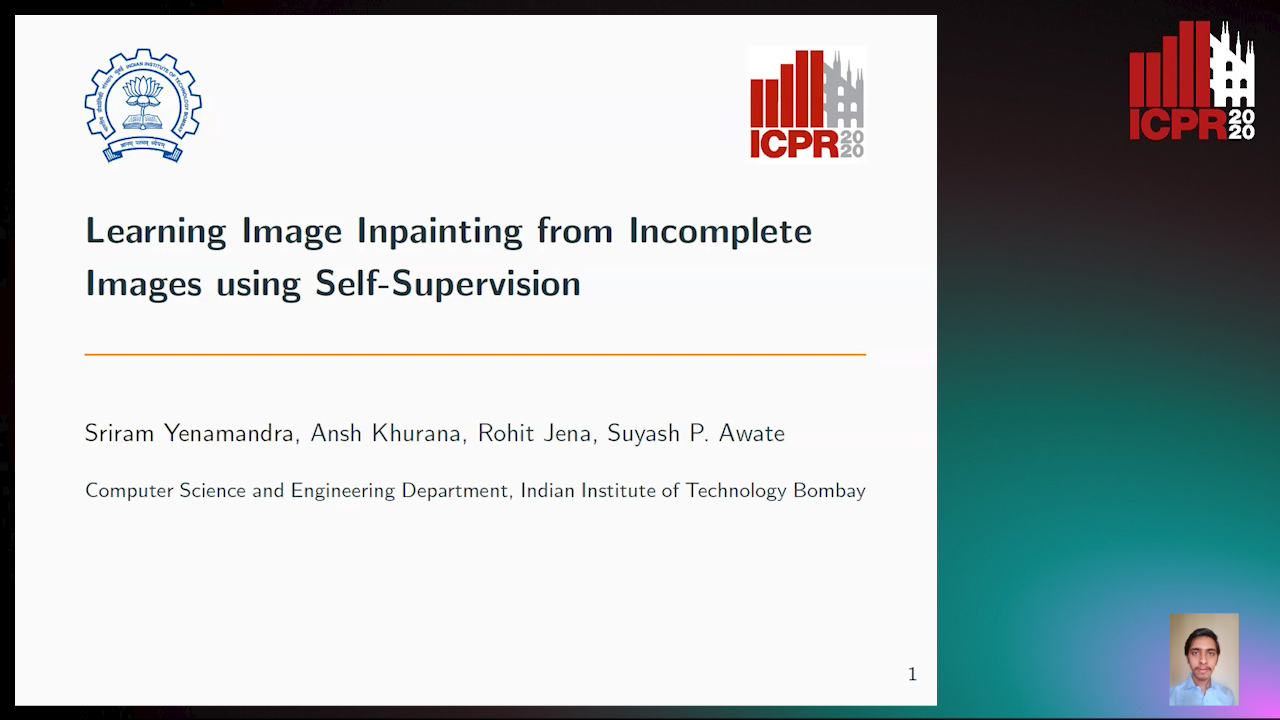
Auto-TLDR; Unsupervised Deep Neural Network for Semantic Image Inpainting
Abstract Slides Poster Similar
Pixel-based Facial Expression Synthesis
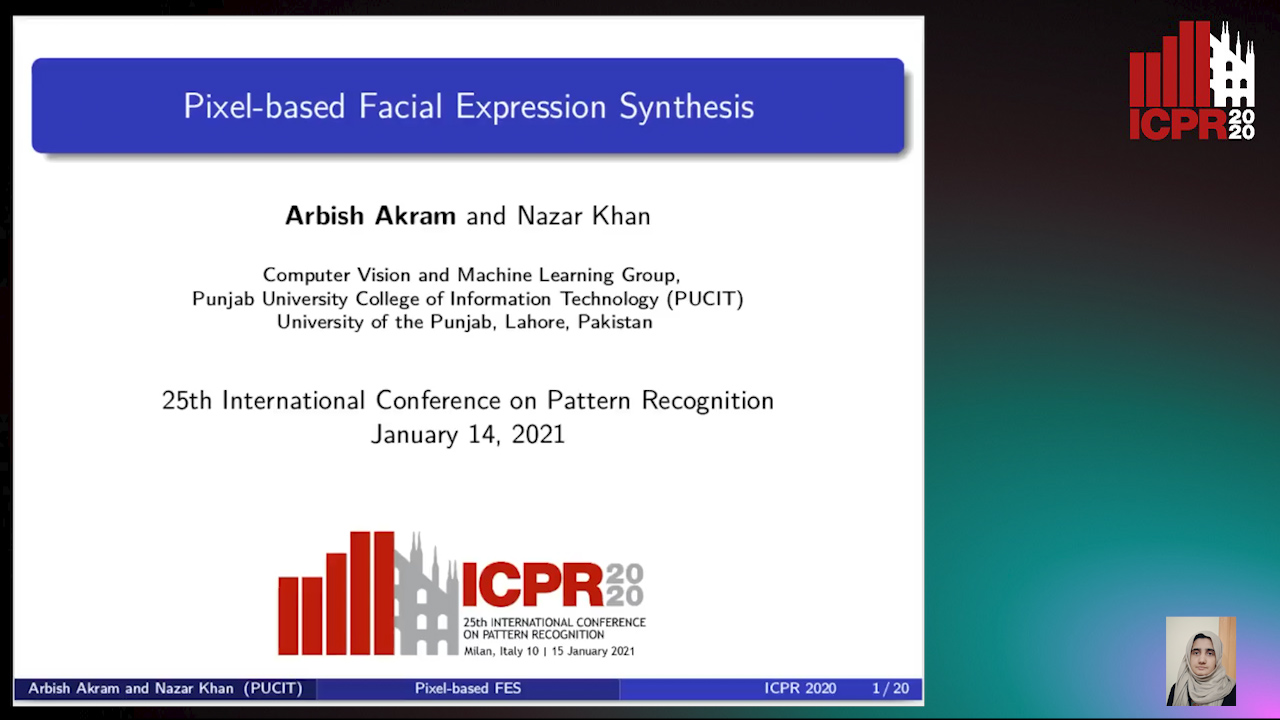
Auto-TLDR; pixel-based facial expression synthesis using GANs
Abstract Slides Poster Similar
Face Super-Resolution Network with Incremental Enhancement of Facial Parsing Information
Shuang Liu, Chengyi Xiong, Zhirong Gao

Auto-TLDR; Learning-based Face Super-Resolution with Incremental Boosting Facial Parsing Information
Abstract Slides Poster Similar
Stylized-Colorization for Line Arts
Tzu-Ting Fang, Minh Duc Vo, Akihiro Sugimoto, Shang-Hong Lai

Auto-TLDR; Stylized-colorization using GAN-based End-to-End Model for Anime
Abstract Slides Poster Similar
Removing Raindrops from a Single Image Using Synthetic Data
Yoshihito Kokubo, Shusaku Asada, Hirotaka Maruyama, Masaru Koide, Kohei Yamamoto, Yoshihisa Suetsugu
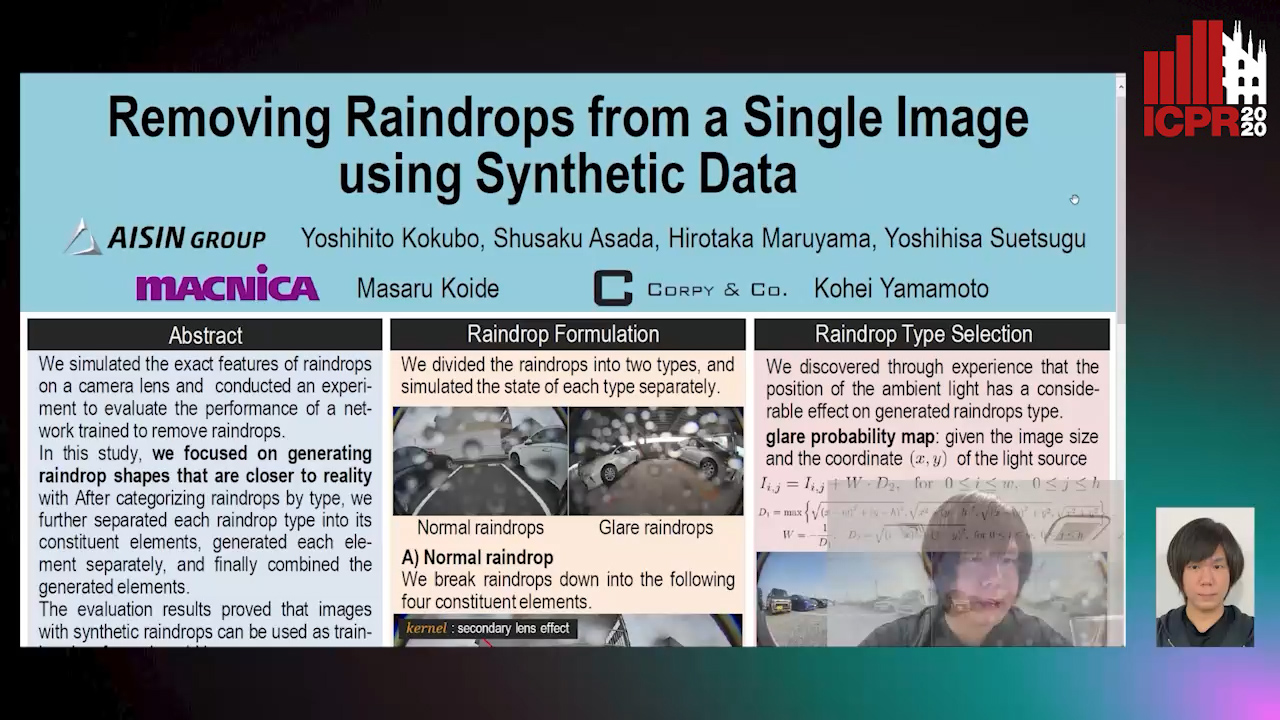
Auto-TLDR; Raindrop Removal Using Synthetic Raindrop Data
Abstract Slides Poster Similar
Boundary Guided Image Translation for Pose Estimation from Ultra-Low Resolution Thermal Sensor
Kohei Kurihara, Tianren Wang, Teng Zhang, Brian Carrington Lovell

Auto-TLDR; Pose Estimation on Low-Resolution Thermal Images Using Image-to-Image Translation Architecture
Abstract Slides Poster Similar
Deep Realistic Novel View Generation for City-Scale Aerial Images
Koundinya Nouduri, Ke Gao, Joshua Fraser, Shizeng Yao, Hadi Aliakbarpour, Filiz Bunyak, Kannappan Palaniappan

Auto-TLDR; End-to-End 3D Voxel Renderer for Multi-View Stereo Data Generation and Evaluation
Abstract Slides Poster Similar